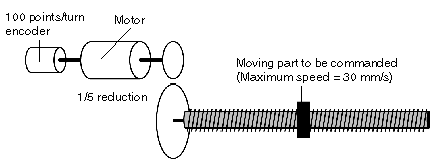The maximum setpoint UMAX is the voltage which has to be applied to the variable speed controller, in order to reach a speed equal to the maximum speed.
Adjusting the Variable Speed Controller
In the absence of any particular speed constraint, the variable speed controller can be adjusted to obtain the maximum speed for a voltage as close as possible to, but less than 9 V.
Limiting voltage to 9 V enables a reserve to be made available during transitory periods allowing a surge speed to be attained. If there are no constraints imposed by the mechanics, or by the maximum acceptable frequency, choose the following value: Maximum setpoint = 9000 mV
We would like to control an axis with the following characteristics:
Desired maximum linear speed of 30 mm/s, or 1800 mm/m. Thread of 5 mm.
The axis is controlled by a motor capable of 3000 rev/min, which drives a ball screw via a speed reducer with a ratio of 1/5. The encoder is on the motor shaft. Let us assume that it is an incremental encoder without multiplication by 4.
The RESOL parameter (distance covered by the moving part between 2 encoder increments) is equal to: Ne x Thread / N = 1/5 x 5 / 1000 = 1 microm
-
The maximum operating speed is 1800 mm/m,
-
Maximum setpoint is the voltage value at which maximum speed can be reached. Considering the reduction ratio (1/5) and the thread size (5 m), the maximum linear speed (1800 mm/min) corresponds to a motor speed of 1800 rev/min.
If the variable speed controller is adjusted to reach a speed of 3000 rev/min with an input voltage of 10 V; in order to reach 1800 rev/min, the voltage must be 6 V (maximum setpoint = 6000 mV).
Consistency of Parameters
The consistency of the RESOL, Maximum speed and Maximum setpoint parameters must be ensured, otherwise inconsistent control loop behavior will result.
